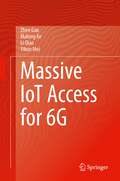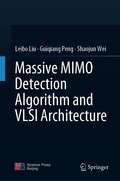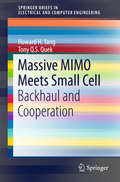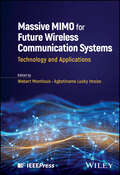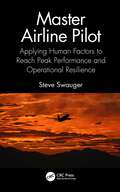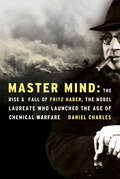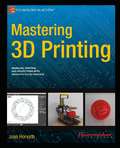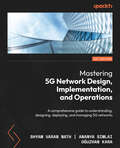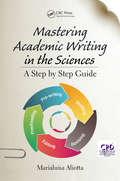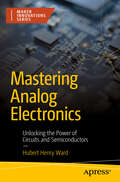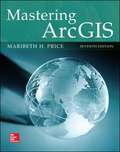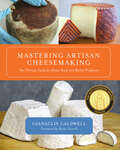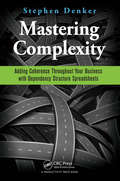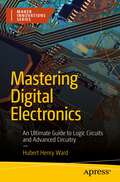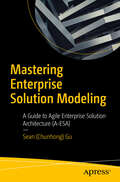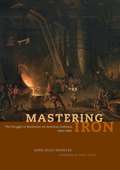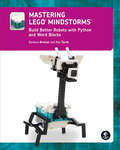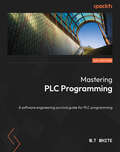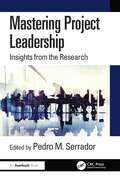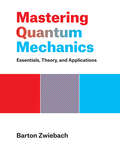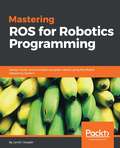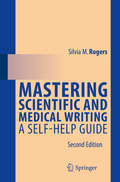- Table View
- List View
Massive IoT Access for 6G
by Li Qiao Zhen Gao Malong Ke Yikun MeiThe Internet-of-Things (IoT) revolution has triggered the need of massive connectivity for billions of devices requiring a system capacity which is far beyond the current network designs that can be supported. This emerging requirement has reshaped the society and industry in pursuing efficient communication paradigm. In particular, massive machine-type communications (mMTC) will be a prime driver for enabling the vision of scalable IoT with heterogeneous applications, where the massive access is of paramount importance. This book discusses important massive IoT scenarios and the key technical requirements of the corresponding massive access. We review the state-of-the-art IoT standards and mMTC solutions, and summarize the limitations of the existing schemes from the perspectives of the network architecture, random access procedure, and multiple access techniques. Here, we specify the massive access challenges and reveal that the facilitation of MTC invokes a dramatically different access scheme from current ones mainly designed for human-centric communications. Moreover, we propose several promising massive access solutions to overcome the limitations, where sufficient theoretical model and algorithm design guidance are provided. Besides, detailed simulation and engineering implementation methods are also included.
Massive MIMO Detection Algorithm and VLSI Architecture
by Leibo Liu Shaojun Wei Guiqiang PengThis book introduces readers to a reconfigurable chip architecture for future wireless communication systems, such as 5G and beyond. The proposed architecture perfectly meets the demands for future mobile communication solutions to support different standards, algorithms, and antenna sizes, and to accommodate the evolution of standards and algorithms. It employs massive MIMO detection algorithms, which combine the advantages of low complexity and high parallelism, and can fully meet the requirements for detection accuracy. Further, the architecture is implemented using ASIC, which offers high energy efficiency, high area efficiency and low detection error. After introducing massive MIMO detection algorithms and circuit architectures, the book describes the ASIC implementation for verifying the massive MIMO detection. In turn, it provides detailed information on the proposed reconfigurable architecture: the data path and configuration path for massive MIMO detection algorithms, including the processing unit, interconnections, storage mechanism, configuration information format, and configuration method.
Massive MIMO Meets Small Cell
by Howard H. Yang Tony Q.S. QuekThis brief explores the utilization of large antenna arrays in massive multiple-input-multiple-output (MIMO) for both interference suppression, where it can improve cell-edge user rates, and for wireless backhaul in small cell networks, where macro base stations can forward data to small access points in an energy efficient way. Massive MIMO is deemed as a critical technology for next generation wireless technology. By deploying an antenna array that has active elements in excess of the number of users, massive MIMO not only provides tremendous diversity gain but also powers new aspects for network design to improve performance. This brief investigates a better utilization of the excessive spatial dimensions to improve network performance. It combines random matrix theory and stochastic geometry to develop an analytical framework that accounts for all the key features of a network, including number of antenna array, base station density, inter-cell interference, random base station deployment, and network traffic load. The authors explore the impact from different network parameters through numerical analysis. Researchers in wireless network design will find this to be an exceptional resource, as will advanced-level students or professionals working in networking and information systems design.
Massive MIMO for Future Wireless Communication Systems: Technology and Applications
by Agbotiname Lucky Imoize Webert MontlouisAuthoritative resource discussing the development of advanced massive multiple input multiple output (MIMO) techniques and algorithms for application in 6G Massive MIMO for Future Wireless Communication Systems analyzes applications and technology trends for massive multiple input multiple output (MIMO) in 6G and beyond, presenting a unified theoretical framework for analyzing the fundamental limits of massive MIMO that considers several practical constraints. In addition, this book develops advanced signal-processing algorithms to enable massive MIMO applications in realistic environments. The book looks closer at applying techniques to massive MIMO in order to meet practical network constraints in 6G networks, such as interference, pathloss, delay, and traffic outage, and provides new insights into real-world deployment scenarios, applications, management, and associated benefits of robust, provably secure, and efficient security and privacy schemes for massive MIMO wireless communication networks. To aid in reader comprehension, this book includes a glossary of terms, resources for further reading via a detailed bibliography, and useful figures and summary tables throughout. With contributions from industry experts and researchers across the world and edited by two leaders in the field, Massive MIMO for Future Wireless Communication Systems includes information on: Signal processing algorithms for cell-free massive MIMO systems and advanced mathematical tools to analyze multiuser dynamics in wireless channelsBit error rate (BER) performance comparisons of different detectors in conventional cell-free massive MIMO systemsEnhancement of massive MIMO using deep learning-based channel estimation and cell-free massive MIMO for wireless federated learningLow-complexity, self-organizing, and energy-efficient massive MIMO architectures, including the prospects and challenges of Terahertz MIMO systems Massive MIMO for Future Wireless Communication Systems is an essential resource on the subject for industry and academic researchers, advanced students, scientists, and engineers in the fields of MIMO, antennas, sensing and channel measurements, and modeling technologies.
Master 76 Option Strategies
by Russell Allen StultzMaster 76 Option Strategies, with its downloadable companion Excel-based options strategy workbook, provides an exceptionally powerful options strategy learning experience. The companion Excel workbook is a “live” option strategy trainer. It contains a Contents page (or worksheet) that lists all 76 option strategy names and descriptions. Clickable links are provided to jump users directly to the corresponding strategy worksheet. Each worksheet is carefully designed to guide users through trade scanning, entry, exit, and the final outcome of the underlying option strategy. Once a trade is entered and working, a return link can be used to return directly to the Contents page. Each trade continues to “work” and can be opened at any time to check either current or final trading outcome. The Excel workbook pulls real-time live market data from the popular thinkorswim® trading platform. Readers can browse the Internet browser to locate thinkorswim® and determine the policies regarding its access and use.
Master Airline Pilot: Applying Human Factors to Reach Peak Performance and Operational Resilience
by Steve SwaugerMaster Airline Pilot offers a process for improving pilots’ skills in risk management, situational awareness building, decision making, communications, and crew management. It links aviation human factors with practical airline operations to promote the development of master-level aviation skills across the full range of pilot experience. Serving as a practical guide for operational aviation challenges, the book discusses exceptional events such as operations under marginal condition, intervening to interdict an unsafe operation, and resolving crew conflicts. It also provides techniques for handling more common airline flying challenges like delays, holding, diverting, and continuing versus aborting a deteriorating game plan. The book is intended for airline pilots, training captains, simulator instructors, and aviation students taking courses in flight safety and crew management to improve their skillset, proficiency, and expertise toward peak performance.
Master Handbook of Acoustics, Sixth Edition
by F. Alton Everest Ken C. PohlmannThe most complete and current guide to architectural acoustics principles and practices <P><P>Design and construct audiophile-quality sonic environments of all sizes--from home theaters and project studios to large-scale recording studios. Thoroughly revised to include new acoustical design techniques, Master Handbook of Acoustics, Sixth Edition, explains the art and science of room acoustics and architecture by combining theoretical instruction with matter-of-fact engineering advice. <P><P>Written by renowned experts in the field and refined through several editions, this fully updated classic describes the fundamentals of acoustical properties, as well as the latest solutions to acoustical problems. Throughout, this authoritative text provides clear explanations, describes hands-on techniques, and features numerous room designs that can be built as presented, or adapted to your particular needs. <ul> <li>Understand how sound waves travel in free fields and in enclosed spaces</li> <li>Learn how human sound perception and psychoacoustics affect room design</li> <li>Calculate and predict reflections, reverberation times, and room modes</li> <li>Perform acoustical measurements and site surveys, and choose construction materials</li> <li>Design, build, and install treatment modules to optimize early reflections, reverberation, and diffusion</li> <li>Design and build home theaters, home studios, control rooms, recording studios, and other acoustically sensitive spaces</li> <li>Reduce HVAC noise levels, and achieve excellent sound isolation with proven wall, window, and door designs</li> <li>Understand the acoustics of auditoriums and concert halls</li> <li>Utilize the supplied cost-effective plans and specifications for a variety of recording and listening rooms</li> </ul>
Master Mind: The Rise & Fall of Fritz Haber, the Nobel Laureate Who Launched the Age of Chemical Warfare
by Daniel Charles“The dramatic life of a German Jewish scientist caught, of his own will, between the promise of science and the annihilation of war.” —Roald Hoffmann, chemist and writerFRITZ HABER—a Nobel laureate in chemistry, a friend of Albert Einstein, a German Jew and World War I hero—may be the most important scientist you have never heard of. The Haber-Bosch process, which he invented at the turn of the twentieth century, revolutionized agriculture by converting nitrogen to fertilizer in quantities massive enough to feed the world. The invention has become an essential pillar for life on earth; some two billion people on our planet could not survive without it. Yet this same process supplied the German military with explosives during World War I, and Haber orchestrated Germany’s use of an entirely new weapon—poison gas. Eventually, Haber’s efforts led to Zyklon B, the gas later used to kill millions—including Haber’s own relatives—in Nazi concentration camps.Master Mind is a thought-provoking biography of this controversial scientist, a modern Faust who personifies the paradox of science, its ability to create and to destroy. It offers a complete chronicle of his tumultuous and ultimately tragic life, from his childhood and rise to prominence in the heady days of the German Empire to his disgrace and exile at the hands of the Nazis; from early decades as the hero who eliminated the threat of starvation to his lingering legacy as a villain whose work led to the demise of millions.“A fascinating tale of science, history, politics, and antisemitism . . . exceptionally compelling reading.” —Deborah Lipstadt, author of Denying the Holocaust
Mastering 3D Printing
by Joan HorvathMastering 3D Printing shows you how to get the most out of your printer, including how to design models, choose materials, work with different printers, and integrate 3D printing with traditional prototyping to make techniques like sand casting more efficient. You've printed key chains. You've printed simple toys. Now you're ready to innovate with your 3D printer to start a business or teach and inspire others. Joan Horvath has been an educator, engineer, author, and startup 3D printing company team member. She shows you all of the technical details you need to know to go beyond simple model printing to make your 3D printer work for you as a prototyping device, a teaching tool, or a business machine.
Mastering 5G Network Design, Implementation, and Operations: A comprehensive guide to understanding, designing, deploying, and managing 5G networks
by Shyam Varan Nath Ananya Simlai Oguzhan KaraLearn 5G network design and implement advanced apps using standalone, non-standalone, and private 5G networks with expert guidance from industry leadersPurchase of the print or kindle book includes a free eBook in the PDF formatKey FeaturesGain a comprehensive understanding of the 5G end-to-end network architectureBuild a foundation to successfully design, implement, manage, and monetize a 5G networkDesign and deploy innovative applications based on 5G networksBook DescriptionWe are living in an era where ultra-fast internet speed is not a want, but a necessity. As applications continue to evolve, they demand a reliable network with low latency and high speed. With the widespread commercial adoption of driverless cars, robotic factory floors, and AR/VR-based immersive sporting events, speed and reliability are becoming more crucial than ever before. Fortunately, the power of 5G technology enables all this and much more.This book helps you understand the fundamental building blocks that enable 5G technology. You'll explore the unique aspects that make 5G capable of meeting high-quality demands, including technologies that back 5G, enhancements in the air interface, and packet core, which come together to create a network with unparalleled performance. As you advance, you'll discover how to design and implement both 5G macro and private networks, while also learning about the various design and deployment options available and which option is best suited for specific use cases. After that, you'll check out the operational and maintenance aspects of such networks and how 5G works together with fixed wireline and satellite technologies.By the end of this book, you'll understand the theoretical and practical aspects of 5G, enabling you to use it as a handbook to establish a 5G network.What you will learnUnderstand the key aspects and methodology of 5G New Radio and NG-RANGet to grips with Voice over New Radio (VoNR) networksGet started with 5G radio planning along with the 5G air interfaceTake a deep dive into the 5G core network and explore the overall 5G network architectureGain a clear understanding of various 5G deployment optionsExplore network slicing and the role it plays in 5GGet an overview of 5G fixed mobile convergence, autonomous vehicles, and satellite communicationsWho this book is forIf you are a telecom enthusiast or work in this domain and are looking to learn more about building a 5G network bottom–up or an application modernization strategy maker, then this book is for you. It provides a consumable understanding of the technology to network engineers, network architects, and infrastructure decision-makers, helping them excel in their day-to-day work involving 5G technology.
Mastering Academic Writing in the Sciences: A Step-by-Step Guide
by Marialuisa AliottaThis book provides a comprehensive and coherent step-by-step guide to writing in scientific academic disciplines. It is an invaluable resource for those working on a PhD thesis, research paper, dissertation, or report. Writing these documents can be a long and arduous experience for students and their supervisors, and even for experienced researchers. However, this book can hold the key to success. Mapping the steps involved in the writing process - from acquiring and organizing sources of information, to revising early drafts, to proofreading the final product - it provides clear guidance on what to write and how best to write it. <P><P>Features: <li>Step-by-step approach to academic writing in scientific disciplines <li>Ideal guidance for PhD theses, papers, grant applications, reports and more <li>Includes worked-out examples from real research papers and PhD theses and templates and worksheets are available online to help readers put specific tasks into practice
Mastering Analog Electronics: Unlocking the Power of Circuits and Semiconductors (Maker Innovations Series)
by Hubert Henry WardEmbark on a transformative journey through the intricate world of analogue electronics. This comprehensive guide is designed to empower learners at every level with the knowledge and practical expertise necessary for a successful career in analogue electronics. Starting with the foundational disparities between analogue and digital electronics, this book provides a clear understanding of current flow, conductors, and insulators. You’ll delve into the realm of semiconductors, uncovering their revolutionary impact and the art of manipulating them through doping techniques. The heart of analogue circuitry comes alive as you explore PN junctions, grasp diode behavior, and utilize TINA 12 ECAD software for hands-on simulations. Transistors and the Opamp then take center-stage, from their configurations to their roles as switches and amplifiers, with practical examples and simulations enhancing your comprehension. Master the unique attributes of bipolar junction transistors and field effect transistors, honing your skills using TINA 12. Dive into operational amplifiers functions, and versatile configurations, and navigate mathematical operations and signal filtering. Whether you're a novice or an experienced engineer, embark on this educational journey today with Mastering Analogue Electronics and unleash your potential in analogue circuit design. What You’ll Learn Understand the dynamics of current flow. Explore semiconductor structures and their role in crafting diodes and transistors. Dive into the world of Uni Junction Transistors and Field Effect Transistors. Design a spectrum of analogue circuits, unleashing your creative potential. Harness the potential of oscillators such as the multivibrator, the 555 timer and the Wien Bridge oscillator. Gain an introduction to the basic low and high pass filters both passive and active. Who This Book Is For This book is tailored for students pursuing engineering qualifications, hobbyists keen on designing analogue circuits, engineers seeking a comprehensive reference on analogue electronics, teachers, and students in need of a valuable teaching resource.
Mastering ArcGIS (Seventh Edition)
by Maribeth PriceMastering ArcGIS is a detailed primer on learning the ArcGIS software. This book is designed to offer everything you need to master the basic elements of GIS. This seventh edition includes strengthening the data management content and places more emphasis on managing and compiling GIS data, as well as writing metadata. Students these days know less about basic computer file system concepts and they need more background and instruction to work effectively with GIS data. The author has added a new chapter on GIS data management to cover these concepts, and reorganized the chapters to cover data management first, which appears to be the way most instructors like to structure their courses. Metadata is more strongly emphasized throughout, first as the simple Item Description and later as standards-based metadata.
Mastering Artisan Cheesemaking: The Ultimate Guide for Home-Scale and Market Producers
by Gianaclis CaldwellForeWord Magazine Book of Year: Gold Winner for Reference"Mastering Artisan Cheesemaking is a wealth of in-depth information won by first-hand experience, yet it&’s friendly and reassuring and skillfully unpacks the science and craft of cheesemaking for the interested hobbyist and the artisan alike. After reading it, I&’m more fascinated by cheese than ever!"—Margo True, Food Editor, Sunset MagazineThe key to becoming a successful artisan cheesemaker is to develop the intuition essential for problem solving and developing unique styles of cheeses. There are an increasing number of books on the market about making cheese, but none approaches the intricacies of cheesemaking science alongside considerations for preparing each type of cheese variety in as much detail as Mastering Artisan Cheesemaking.Indeed, this book fills a big hole in the market. Beginner guides leave you wanting more content and explanation of process, while recipe-based cookbooks often fail to dig deeper into the science, and therefore don&’t allow for a truly intuitive cheesemaker to develop. Acclaimed cheesemaker Gianaclis Caldwell has written the book she wishes existed when she was starting out. Every serious home-scale artisan cheesemaker—even those just beginning to experiment—will want this book as their bible to take them from their first quick mozzarella to a French mimolette, and ultimately to designing their own unique cheeses.This comprehensive and user-friendly guide thoroughly explains the art and science that allow milk to be transformed into epicurean masterpieces. Caldwell offers a deep look at the history, science, culture, and art of making artisan cheese on a small scale, and includes detailed information on equipment and setting up a home-scale operation. A large part of the book includes extensive process-based recipes dictating not only the hard numbers, but also the concepts behind each style of cheese and everything you want to know about affinage (aging) and using oils, brushes, waxes, infusions, and other creative aging and flavoring techniques. Also included are beautiful photographs, profiles of other cheesemakers, and in-depth appendices for quick reference in the preparation and aging room. Mastering Artisan Cheesemaking will also prove an invaluable resource for those with, or thinking of starting, a small-scale creamery.Let Gianaclis Caldwell be your mentor, guide, and cheering section as you follow the pathway to a mastery of cheesemaking. For the avid home hobbyist to the serious commercial artisan, Mastering Artisan Cheesemaking is an irreplaceable resource.
Mastering Complexity: Adding Coherence Throughout Your Business with Dependency Structure Spreadsheets
by Stephen DenkerMastering Complexity is designed to help readers develop and maintain logical, adaptable solutions to business problems. It demonstrates how to visualize business dependency connections with a square spreadsheet called a Dependency Structure Matrix (DSM). Once the links representing dependencies are visualized in a DSM, it can be used to improve th
Mastering Digital Electronics: An Ultimate Guide to Logic Circuits and Advanced Circuitry (Maker Innovations Series)
by Hubert Henry WardDiscover the essential knowledge and practical skills to excel in the dynamic field of digital electronics with "Mastering Digital Electronics." From the fundamentals of diode resistor logic to unraveling the intricacies of TTL and CMOS logic gates, this book takes you on a journey through the evolution of digital electronics. Starting with the humble SR latch and progressing to the revolutionary JK flip flop that powers today's computer technology, you'll gain a solid foundation in binary arithmetic, Boolean algebra, and the representation and optimization of digital circuits.The book gives a firm understanding of digital electronics, then moves on to using standard design methods, such as state diagrams, to design everyday logic circuits such as counters, shift registers, PISO, and SIPO registers. It delves into how to design some challenging digital circuits such as a crossroad set of traffic lights with a pelican crossing and how to use the 555 timer to control a variety of applications. At every stage of the book, you will be learning how to use TINA version 12, an industry standard ECAD and many of its functions. Moreover, the book ventures into using the software to simulate and so confirm all the circuits you design.For readers interested in advancing to the practical implementation of the circuits discussed, the book provides opportunities to design PCB circuit boards for selected circuits using the software. This book will suit any student of digital electronics at any level and provide them with essential reference material for them to start a career in digital electronics.What You’ll LearnWhat logic gates are, and the difference between sequential and combinational logic. How to use binary numbers and how to perform all arithmetic operations Learn about the five basic logic gates; AND, NAND, OR, NOR and EXOR gates. How to minimize logic circuits using Boolean algebra and Karnaugh maps.How to state diagrams to design logic circuits.How to design a range of logic circuits.Learn about combinational circuits and the half and full adder as well as a logic circuit to subtract binary numbers.Learn about the 555 timer and how to apply it to a range of logic circuits.Who This Book Is ForStudents who are studying for an engineering qualification. Hobbyist who wants to design digitalcircuits Engineers who need a go-to reference book on digital electronics.
Mastering Enterprise Solution Modeling: A Guide to Agile Enterprise Solution Architecture (A-ESA)
by Sean (Chunhong) GuEmbark on a journey through the Agile-Enterprise Solution Architecture (A-ESA) framework with this in-depth guide designed to provide a structured approach to IT solution modeling. The modeling approach is based on the principles of simplicity, significance, and systematics. It effectively addresses architectural debt issues in today's agile and large-scale IT solutions. Beginning with a foundational overview of A-ESA model specifications, the book introduces readers to the intent and unique methodologies behind A-ESA. It then delves into practical demonstrations through example solution cases, offering real-world context and insights into various architectural styles. Each chapter builds on this knowledge, covering the governing ideas of the thinking framework and essential topics such as key metrics, and modeling considerations for diverse architectural styles, ensuring a thorough understanding of A-ESA's application in different contexts. The book also emphasizes the link between enterprise architecture (EA) and solution architecture (SA), and the importance of governance and measurement in maintaining the integrity and effectiveness of architectural solutions. Readers will explore critical metrics, governance techniques, and the impact of agile modeling on purpose and architectural leading practices. With practical examples, measurement techniques, and governance strategies, this guide equips readers with the cognitive and practical tools necessary for strategic and effective architectural thinking. Concluding with reflections and future outlooks, this comprehensive guide offers valuable insights for mastering IT solution modeling within the A-ESA framework. You Will: Gain hands-on experience with the Agile-Enterprise Solution Architecture (A-ESA) framework through detailed examples and solution cases that illustrate various architectural styles and modeling techniques. Understand the critical metrics and model mappings necessary for evaluating architectural quality and performance. Develop a deep understanding of the A-ESA architectural thinking, including strategic, enterprise, business, data, and cloud architecture considerations This book is for : IT architects, enterprise architects, and solutions architects.
Mastering Iron: The Struggle to Modernize an American Industry
by Anne Kelly KnowlesVeins of iron run deep in the history of America. Iron making began almost as soon as European settlement, with the establishment of the first ironworks in colonial Massachusetts. Yet it was Great Britain that became the Atlantic worldOCOs dominant low-cost, high-volume producer of iron, a position it retained throughout the nineteenth century. It was not until after the Civil War that American iron producers began to match the scale and efficiency of the British iron industry. aIn "Mastering Iron," Anne Kelly Knowles argues that the prolonged development of the US iron industry was largely due to geographical problems the British did not face. Pairing exhaustive manuscript research with analysis of a detailed geospatial database that she built of the industry, Knowles reconstructs the American iron industry in unprecedented depth, from locating hundreds of iron companies in their social and environmental contexts to explaining workplace culture and social relations between workers and managers. She demonstrates how ironworks in Alabama, Maryland, Pennsylvania, and Virginia struggled to replicate British technologies but, in the attempt, brought about changes in the American industry that set the stage for the subsequent age of steel. aRichly illustrated with dozens of original maps and period art work, all in full color, "Mastering Iron" sheds new light on American ambitions and highlights the challenges a young nation faced as it grappled with its geographic conditions. "
Mastering LEGO® MINDSTORMS: Build Better Robots with Python and Word Blocks
by Barbara Bratzel Rob TorokTake your robotics skills to the next level with this guide to mastering LEGO® MINDSTORMS Robot Inventor and LEGO® SPIKE Prime.You&’ve learned the basics of LEGO® robotics with your Robot Inventor or SPIKE Prime kit, and now you&’re ready for more. This full-color, illustrated guidebook to programming your robotic creations teaches you everything you need to know to level up your engineering skills, using examples relevant to both sets. In no time, you&’ll be coding movements for autonomous robot vehicles, building interactive games, making LEGO® musical instruments, and more.Rather than feature step-by-step instructions for building a handful of models, you&’ll find essential information and expert tips and tricks for designing, building, and programming your own robotic creations. The book teaches the fundamentals of writing text-based code for your robots using the popular Python programming language; shows how to harness gears, linkages, and other mechanisms to create all kinds of motion; and explores sophisticated programming techniques for popular applications such as line following and obstacle avoidance, using both Python and Scratch-based Word Blocks. As you learn, loads of challenges and open-ended projects will inspire you to try out ideas.
Mastering PLC Programming: The software engineering survival guide to automation programming
by M. T. WhiteLearn PLC programming from the software perspective to understand advanced concepts such as OOP and HMI development and design reusable, portable, and robust codePurchase of the print or Kindle book includes a free PDF eBookKey FeaturesTake a deep dive into object-oriented PLC programming to gain hands-on knowledgeExplore software engineering concepts such as SDLC, debugging, and SOLID programmingGet a thorough grasp on HMI development to build various HMI projectsBook DescriptionObject-oriented programming (OOP) is a new feature of PLC programming that has taken the automation world by storm. This book provides you with the necessary skills to succeed in the modern automation programming environment.The book is designed in a way to take you through advanced topics such as OOP design, SOLID programming, the software development lifecycle (SDLC), library design, HMI development, general software engineering practices, and more. To hone your programming skills, each chapter has a simulated real-world project that'll enable you to apply the skills you've learned. In all, this book not only covers complex PLC programming topics, but it also removes the financial barrier that comes with most books as all examples utilize free software. This means that to follow along, you DO NOT need to purchase any PLC hardware or software.By the end of this PLC book, you will have what it takes to create long-lasting codebases for any modern automation project.What you will learnFind out how to write PLC programs using advanced programming techniquesExplore OOP concepts for PLC programmingDelve into software engineering topics such as libraries and SOLID programmingExplore HMIs, HMI controls, HMI layouts, and alarmsCreate an HMI project and attach it to a PLC in CODESYSGain hands-on experience by building simulated PLC and HMI projectsWho this book is forThis book is for automaton programmers with a background in software engineering topics such as object-oriented programming and general software engineering knowledge. Automation engineers, software engineers, electrical engineers, PLC technicians, hobbyists, and upper-level university students with an interest in automation or robotics will also find this book useful and interesting. Anyone with a basic knowledge of PLCs can benefit from reading this book.
Mastering PLC Programming: The software engineering survival guide to automation programming
by M. T. WhiteLearn PLC programming from the software perspective to understand advanced concepts such as OOP and HMI development and design reusable, portable, and robust code Purchase of the print or Kindle book includes a free PDF eBookKey FeaturesTake a deep dive into object-oriented PLC programming to gain hands-on knowledgeExplore software engineering concepts such as SDLC, debugging, and SOLID programmingGet a thorough grasp on HMI development to build various HMI projectsBook DescriptionObject-oriented programming (OOP) is a new feature of PLC programming that has taken the automation world by storm. This book provides you with the necessary skills to succeed in the modern automation programming environment. The book is designed in a way to take you through advanced topics such as OOP design, SOLID programming, the software development lifecycle (SDLC), library design, HMI development, general software engineering practices, and more. To hone your programming skills, each chapter has a simulated real-world project that’ll enable you to apply the skills you’ve learned. In all, this book not only covers complex PLC programming topics, but it also removes the financial barrier that comes with most books as all examples utilize free software. This means that to follow along, you DO NOT need to purchase any PLC hardware or software. By the end of this PLC book, you will have what it takes to create long-lasting codebases for any modern automation project.What you will learnFind out how to write PLC programs using advanced programming techniquesExplore OOP concepts for PLC programmingDelve into software engineering topics such as libraries and SOLID programmingExplore HMIs, HMI controls, HMI layouts, and alarmsCreate an HMI project and attach it to a PLC in CODESYSGain hands-on experience by building simulated PLC and HMI projectsWho this book is forThis book is for automaton programmers with a background in software engineering topics such as object-oriented programming and general software engineering knowledge. Automation engineers, software engineers, electrical engineers, PLC technicians, hobbyists, and upper-level university students with an interest in automation or robotics will also find this book useful and interesting. Anyone with a basic knowledge of PLCs can benefit from reading this book.
Mastering Project Leadership: Insights from the Research
by Pedro M. SerradorThis is a collection of essays from key researchers in the field of project management who describe what they feel are the most impactful findings from research. In the challenging and competitive world of project management, project managers need all the insight they can get. Leading researchers share what they believe are the most important findings from the research being done today. These cover pressing topics confronting project managers, including hybrid methodologies, schedule overruns, schedule estimation, project efficiency, and managing local stakeholders. Highlights include the following: Jeff Pinto and Kate Davis explore the “Normalization of Deviance” (NoD) phenomenon within various organizational settings, focusing on projects. NoD involves the gradual acceptance of deviant practices, diverging from established norms, and often leading to detrimental outcomes. Francesco Di Maddaloni investigates how local communities’ stakeholders are perceived, identified, and categorized by project managers in major public infrastructure and construction projects (MPIC). His chapter helps project managers to have a better understanding of a more inclusive and holistic approach to engage with a broader range of stakeholders. Lavagnon Ika, Peter Love, and Jeff Pinto suggest that error and bias combine to exact a toll on major projects, offer theoretical insights, and outline practical recommendations for project managers. Jonas Söderlund offers managerial guidelines for leveraging deadlines as powerful tools for generating project success. Pedro M. Serrado looks at empirical studies that link planning quality to project success, emphasizing its importance. He also discusses the downsides of excessive planning, particularly in dynamic environments and research and development projects.
Mastering Quantum Mechanics: Essentials, Theory, and Applications
by Barton ZwiebachA complete overview of quantum mechanics, covering essential concepts and results, theoretical foundations, and applications.This undergraduate textbook offers a comprehensive overview of quantum mechanics, beginning with essential concepts and results, proceeding through the theoretical foundations that provide the field&’s conceptual framework, and concluding with the tools and applications students will need for advanced studies and for research. Drawn from lectures created for MIT undergraduates and for the popular MITx online course, &“Mastering Quantum Mechanics,&” the text presents the material in a modern and approachable manner while still including the traditional topics necessary for a well-rounded understanding of the subject. As the book progresses, the treatment gradually increases in difficulty, matching students&’ increasingly sophisticated understanding of the material. • Part 1 covers states and probability amplitudes, the Schrödinger equation, energy eigenstates of particles in potentials, the hydrogen atom, and spin one-half particles• Part 2 covers mathematical tools, the pictures of quantum mechanics and the axioms of quantum mechanics, entanglement and tensor products, angular momentum, and identical particles.• Part 3 introduces tools and techniques that help students master the theoretical concepts with a focus on approximation methods.• 236 exercises and 286 end-of-chapter problems• 248 figures
Mastering ROS for Robotics Programming
by Lentin Joseph<P><P>Design, build and simulate complex robots using Robot Operating System and master its out-of-the-box functionalities <P><P>Key Features <P><P>Develop complex robotic applications using ROS for interfacing robot manipulators and mobile robots with the help of high end robotic sensors <P><P>Gain insights into autonomous navigation in mobile robot and motion planning in robot manipulators <P><P>Discover the best practices and troubleshooting solutions everyone needs when working on ROS <P><P>Book Description <P><P>The area of robotics is gaining huge momentum among corporate people, researchers, hobbyists, and students. The major challenge in robotics is its controlling software. The Robot Operating System (ROS) is a modular software platform to develop generic robotic applications. <P><P>This book discusses the advanced concepts in robotics and how to program using ROS. It starts with deep overview of the ROS framework, which will give you a clear idea of how ROS really works. During the course of the book, you will learn how to build models of complex robots, and simulate and interface the robot using the ROS MoveIt motion planning library and ROS navigation stacks. <P><P>After discussing robot manipulation and navigation in robots, you will get to grips with the interfacing I/O boards, sensors, and actuators of ROS. One of the essential ingredients of robots are vision sensors, and an entire chapter is dedicated to the vision sensor, its interfacing in ROS, and its programming. <P><P>You will discuss the hardware interfacing and simulation of complex robot to ROS and ROS Industrial (Package used for interfacing industrial robots). <P><P>Finally, you will get to know the best practices to follow when programming using ROS. <P><P>What you will learn <P><P>Create a robot model of a Seven-DOF robotic arm and a differential wheeled mobile robot <P><P>Work with motion planning of a Seven-DOF arm using MoveIt! <P><P>Implement autonomous navigation in differential drive robots using SLAM and AMCL packages in ROS <P><P>Dig deep into the ROS Pluginlib, ROS nodelets, and Gazebo plugins <P><P>Interface I/O boards such as Arduino, Robot sensors, and High end actuators with ROS <P><P>Simulation and motion planning of ABB and Universal arm using ROS Industrial <P><P>Explore the ROS framework using its latest version
Mastering Scientific and Medical Writing
by Silvia M. RogersThis self-help guide is intended for scientists and medical professionals and students who wish to improve their scientific writing skills. Exercises invite the reader to practice the most important aspects of scientific writing. Although the book addresses certain issues more troublesome to scientific communicators of a non-English language origin, the guide will be of equal benefit to those whose first language is English. If you want not only to write but to write well, this book is for you. This second edition takes into account new developments in the area of scientific communication. In particular, the importance of authenticity is addressed, drawing attention to the sensitive issue of plagiarism in scientific texts.
